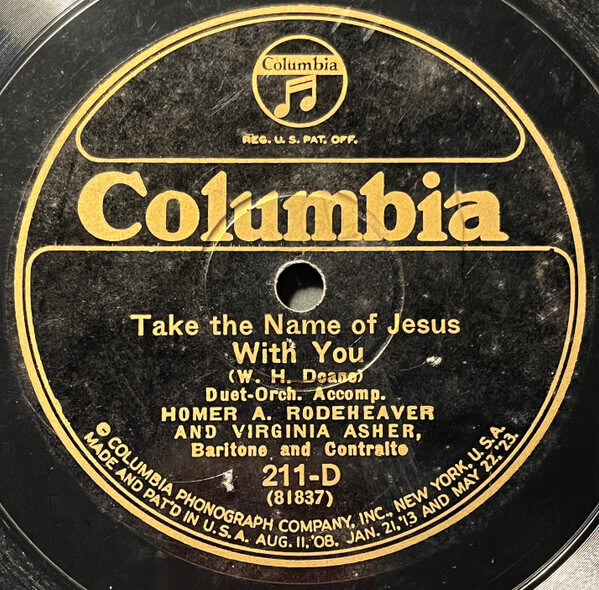The Story Behind: Precious Name (Take the Name of Jesus with You)
By Don Chapman
New York City, 1870. Carriage wheels rattle across Broadway while, upstairs in a modest brownstone, an invalid woman props a worn Bible against her knees. Pain has been Lydia Baxter’s constant companion for nearly thirty years, yet as her pen glides across the page, her suffering seems distant. “I have a very special armor,” she whispers to a visitor. “I have the Name of Jesus.” From her home, Lydia shapes the lines destined to reach the far corners of the earth:
Precious Name, oh how sweet, hope of Earth and joy of Heav’n…
The journey of Lydia’s hymn – from a bedridden woman’s heart to the lips of millions around the world – has only just begun.
Early Life and Conversion

Lydia Odell was born in Petersburg, New York, 1809. Growing up, Lydia’s spiritual journey began when she and her sister Mary encountered a Baptist missionary named Reverend Eben Tucker. The sisters were so moved by his message that they helped establish the first Baptist church in Petersburg in 1820 – a church that continues to this day. Lydia’s early life was marked by her dedication to Sunday School teaching and active involvement in church ministries. She was a woman whose faith took action rather than remaining idle.
Marriage and Ministry
In 1832, at the age of twenty-three, Lydia married John C. Baxter, a businessman and ship chandler. Through her loving influence, John came to embrace the Christian faith as well. The couple later moved to New York City, where they established a home that became known as a gathering place for ministers, evangelists, and Christian workers. Their home was a lighthouse in the big city, offering respite to those spreading the gospel. But soon after moving to New York, God had a different path for Lydia – one that would take her through the valley of suffering.
The Valley of Suffering
Shortly after moving to New York City, Lydia developed a serious chronic illness that would confine her to bed for most of her remaining life – nearly three decades. While many would have grown bitter from such an affliction, Lydia’s response was quite the opposite. Through her illness, she maintained a remarkably cheerful and patient disposition that inspired everyone around her. Friends often remarked that they came to offer comfort but left having received it instead.
During those years of confinement, Lydia devoted herself to intensive Bible study and writing. She published a collection of devotional poems titled “Gems by the Wayside” in 1855. The introduction to this work reveals her perspective on suffering: “Many of these effusions have been penciled while suffering affliction from the hand of a merciful God.” For Lydia, even pain came from a merciful hand.
Lydia had a particular fascination with Biblical names and their meanings, a subject she studied extensively during her years of confinement. Among all Biblical names, she found the name of Jesus most precious. When asked how she maintained her positive outlook despite her physical suffering, Lydia would simply reply: “I have a very special armor. I have the name of Jesus. When the tempter tries to make me blue or despondent, I mention the name of Jesus, and he can’t get through to me anymore.”
The Birth of a Hymn
This personal practice of invoking Jesus’ name as spiritual protection became the inspiration for her most famous hymn, “Take the Name of Jesus with You.” She wrote the hymn in 1870, just four years before her death. Later, the talented musician William Doane would compose a fitting melody that brought her words to life. For Lydia, writing this hymn was not merely a creative outlet during her illness but a ministry – her way of sharing the comfort she had found in Jesus’ name with others. Through her bedridden years, she had discovered a powerful spiritual truth, and now she was offering that same comfort to anyone who would read or sing her words.
The opening lines capture her heartfelt advice to fellow sufferers:
Take the name of Jesus with you,
Child of sorrow and of woe,
It will joy and comfort give you;
Take it then, where’er you go.
William Howard Doane: The Musical Partner

For the music of her hymn, God provided a perfect partner: William Howard Doane. Born in 1832 in Preston, Connecticut, Doane was a man of remarkable talent and success. By his early teens, he had already mastered the flute, violin, and double bass fiddle. His formal musical involvement began at Woodstock Academy, where he served as choir director at the mere age of fourteen.
Though his business career was impressive – he eventually became president of J.A. Fay & Company and held over seventy patents for machinery improvements – Doane’s true passion was musical composition. Despite his demanding business responsibilities, he wrote approximately 2,300 pieces, including hymns, songs, cantatas, and instrumental works. His most famous collaboration was with the blind hymn writer Fanny Crosby, resulting in classics such as “Safe in the Arms of Jesus” and “Rescue the Perishing.”
When Doane found Lydia Baxter’s lyrics for “Take the Name of Jesus with You,” he composed a tune that perfectly captured the comfort and joy expressed in her words. The hymn was first published in 1871 in the hymnal “Pure Gold for the Sunday School,” a collection edited by Doane and Robert Lowry for Biglow and Main publishers.
Historical Context
“Take the Name of Jesus with You” emerged during a boom in gospel songwriting in the late 19th century. The aftermath of the American Civil War saw a surge of evangelistic activity and the rise of gospel hymn collections intended for laypeople and children. This was a time when simple, heartfelt songs were increasingly used in Sunday schools and revival meetings
The hymn fit perfectly into this post-Civil War context with its encouraging message and easy-to-sing refrain. The choice to include “Precious Name” in a Sunday school hymnal reflects the hymn’s initial intended use: it was meant to teach and inspire young people and congregations in an era when many sought comfort in singing about the comforting name of Jesus.
The collaboration between Baxter and Doane exemplified a common practice in the gospel songwriting era – a poet would supply lyrics to a composer to set to music. This partnership approach helped create thousands of hymns that still resonate with believers today.
The Message in the Music
The hymn’s message is simple yet profound. The first verse invites the “child of sorrow and of woe” to take Jesus’ name as a source of “joy and comfort.” The second verse speaks of using Jesus’ name “as a shield from every snare” – exactly how Lydia had used it in her own struggles:
Take the name of Jesus ever,
As a shield from every snare;
If temptations round you gather,
Breathe that holy name in prayer.
While the final verse looks forward to the day when believers will crown Jesus in heaven:
At the name of Jesus bowing,
Falling prostrate at His feet,
King of kings in heaven we’ll crown Him,
When our journey is complete.
The hymn’s memorable refrain – “Precious name, O how sweet! Hope of earth and joy of heaven” – lent itself to repetition and quick memorization, which helped it gain popularity. This refrain perfectly captures the hymn’s central message: that Jesus’ name offers both present comfort and future hope.
From Revival Meetings to Global Impact
“Take the Name of Jesus with You” quickly gained popularity through its use in revival meetings led by evangelist Dwight L. Moody and his music director Ira D. Sankey. It appeared as number 148 in Sankey’s influential collection “Sacred Songs and Solos,” ensuring its widespread use throughout America and Great Britain.
By the end of the 19th century, “Precious Name” appeared in numerous hymnals and song collections. According to Hymnary.org, it has been published in over 600 hymnals to date. The hymn has been included in Baptist, Methodist, Presbyterian, and many other denominational hymn books.
The hymn’s simple yet profound message about finding strength in Jesus’ name resonated with generations of Christians, particularly those facing hardship or suffering. Hymnologist Kenneth Osbeck notes that it became the most enduring of Lydia Baxter’s hymns. Translations of the hymn were made as well; for example, a Swahili version titled “Amini Jina la Yesu” allowed the song to be sung by Christians in other languages.
The Hymn in Popular Culture
Over time, “Take the Name of Jesus with You” became more than just a song – it grew into a part of Christian cultural memory. In the early 20th century, the hymn was popular enough to be recorded and performed beyond just church congregations. In June 1924, famed gospel singer Homer A. Rodeheaver (who had been Billy Sunday’s song leader) recorded the hymn as a vocal duet with contralto Virginia Asher for Columbia Records. This recording, featuring orchestra accompaniment, brought the hymn to listeners through the new medium of phonograph records. As one of the most prolific sacred recording artists of that era, Rodeheaver’s rendition introduced the hymn to even wider audiences. Listen to it here – I wonder what Rodeheaver would have thought of my arrangement? As the visionary he was, he would have probably been fascinated by the modern technology – everything you hear in my version is created by computer software!

In subsequent decades, the hymn remained a favorite in evangelical circles. Notably, in 1959, the well-known singer Pat Boone – a pop star who often recorded Christian songs – included “Take the Name of Jesus With You” on his album “He Leadeth Me,” bringing the old hymn into mid-20th-century popular gospel repertoire. Countless church choirs and soloists have also performed the song. It has appeared on Christian radio programs and in hymn-sing recordings, especially those reviving the “old-time gospel” classics.
Throughout its history, “Precious Name” has been used as a teaching tool and a spiritual reminder. Sunday school teachers taught it to children to instill reverence for Jesus. Missionaries carried it abroad as part of the core of hymns translated and taught in new congregations. Evangelist campaigns in the late 19th and early 20th centuries often reported crowds singing “Precious Name” along with other well-known hymns of the day.
Enduring Legacy
Today, over 150 years after it was written, “Take the Name of Jesus with You” continues to be sung in churches around the world. Its message of hope and consolation remains as relevant as ever – Christians still find encouragement in the idea that Jesus’ name is a sweet, powerful presence with them in daily life. The hymn’s refrain is instantly recognizable to many, and its theme is timeless.
From a bedridden woman in 19th century New York to congregations across the globe, Lydia Baxter’s personal practice of calling on Jesus’ name continues to bless those who embrace it. So the next time life’s troubles seem overwhelming, remember Lydia Baxter and her “special armor.” For in the name of Jesus – the precious name – there is comfort for today and hope for tomorrow!
“Precious Name” Lyrics Video
Download sheet music, chord charts, tracks, multitracks and instrumental parts for Precious Name exclusively with a hymncharts subscription. You won’t find this arrangement on any other website.


